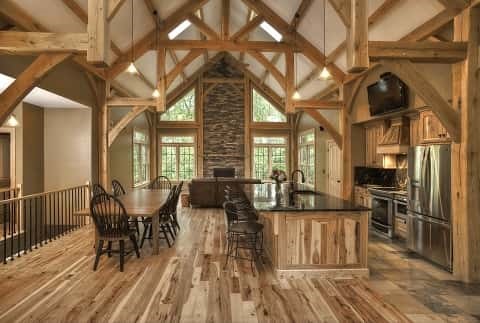
Log homes, timberframe and post-and-beam homes represent a tradition of craftsmanship that goes back thousands of years.
They’re still winning the hearts of people who have a strong affinity for the look and feel of wood.
Today, there are a multitude of choices as far as size, floor plan, architectural style and finish. Even though most manufacturers prefabricate the shells of the homes in a factory, the finished product is almost always one of a kind.
What’s the Difference?
According to the National Association of Home Builders (NAHB) Log and Timber Homes Council, the fundamental difference between log and timberframe construction is in how the solid wood components are used. In a log home, the logs are typically stacked horizontally and are the primary building material that comprises the load-bearing walls.
Post-and-beam structures have upright posts that support horizontal beams. The framing uses simple half-lap joinery, where two timbers are notched together at approximately half their depth. The main load-bearing members support joists and rafters that are notched into the beams. Metal brackets or fasteners hold the framing components together.
Timber framing utilizes wood joinery, such as mortise and tenon. A mortise, or hole, on the end of one timber connects to a corresponding tenon, or tongue, on the other. The joints are reinforced by wooden pegs.
Most logs are milled to a specific profile and precut to fit a particular home design, but some companies cut the logs by hand in a log yard and reassemble them on the site. Timbers, too, may either be milled or hand-hewn. Logs or timbers that are hand-hewn will vary in size and texture.
Log Homes
While full log homes are still popular, there’s a growing demand for hybrids. These have “a very loggy feel,” but incorporate a mixed of interior materials and, occasionally, timberframe trusses or other accents, says Donna Peak, executive director of the National Association of Home Builders (NAHB) Building Systems Councils.
“That whole marketplace has really started to explode to the point where a lot of traditional log-home manufacturers are branching out into hybrids,” says Peak.
Logs are typically 6, 8, 10 and 12 inches thick, but can be as large as 14 inches in diameter. They’re available in various shapes, including square, round and D-shape.
Due to variations in materials, log sizes and log and corner profiles, log homes offer considerable design flexibility. The small, dark cabins of yesteryear have evolved into spacious homes with modern kitchens, two-story great rooms and walls of windows that embrace views of the surrounding landscape.
Logs absorb heat energy during the day and radiate it at night, keeping the interior of the home comfortable, while using less energy over the life of the structure. According to an NAHB study, homes built with solid log walls are typically 2.5 percent to 15 percent more energy efficient than standard stick-frame construction.
Timberframe Homes
In a timberframe home, large wood posts and beams form the structural support and require no interior load-bearing walls. Once the frame is erected, the walls — which are often structural insulated panels, or SIPs — are put in place, leaving the wood exposed on the inside. The exterior can be finished with any material, including logs, siding, stone and brick. Different types of trusses give each home a distinctive appearance.
SIPs and insulated concrete forms, or ICFs, substantially increase the energy efficiency of timberframe homes. And due to their solidity, timberframes tend to do a better job of absorbing the impact of earthquakes, hurricanes and tornadoes.
Post-and-Beam Homes
Picture the old red barn in the Norman Rockwell paintings and you know what a traditional post-and-beam structure looks like. The barn is still the most popular post-and-beam design, but contemporary, shingle-style and other designs are also offered.
“The look can be as clean as the customer wants it,” says Signe Benson, vice president of marketing for Seattle-based Lindal Cedar Homes. “We can hide all the posts and beams in the wall or expose them.”
The reason a post-and-beam house is so customizable, says national sales manager Christina Lindal, is because the entire load is on the posts and the beams; there are few bearing walls. “Moving walls, unlike in a conventionally framed home, is very easy to do,” says Lindal.
Post-and-beam manufacturers generally use Douglas fir for the posts and beams. Some use glulam (glued and laminated) beams, because they aren’t prone to cracks and splits like wood timbers.
Regardless of the type of wood home you choose, you can have a home that’s stylish and inviting and fits your family’s lifestyle for many years to come.
SOURCE: www.newhomesource.com





Recent Comments